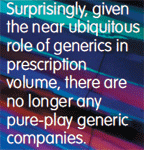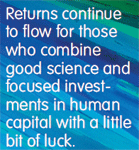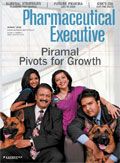Sunny Outlook for Biopharm 2020?
Albert Wertheimer looks beyond today's dark clouds with a comparatively sunny forecast for the biopharm industry in 2020-just watch out for the harsh light of complacency.
Our look into the future begins with a familiar format: a meeting, taking place in the United States, which is still where the money is, and where for that reason strategic and operational issues are vetted for execution in a thoroughly global pharmaceutical organization. What is different is that the CEO is a female and her team is convening at the ungodly hour of 3 a.m. for that important monthly conversation with division heads from facilities and offices around the world. Since most of the R&D, production, packaging, clinical trials, medical communications, regulatory affairs, and pharmacovigilance activities take place in India or China, where it is mid-afternoon, the meetings are held at this time.
Before the meeting began, several of the officers were reminiscing about the days in the early 2000s when most of those functions were performed in the United States. Some lamented those middle management colleagues who had passed on the opportunity to learn Mandarin earlier in their careers and now faced more limited career prospects.
It's worth taking a closer look at the strategic forces underpinning today's discussion. Surprisingly, sales leadership in the industry has remained remarkably stable, with few new entrants to the top-10 players—Israeli-based Teva is the exception that proves the rule, having earned a place on the list by combining state-of-the-art efficiencies around low-end generics with a growing stake in biosimilars and innovative specialty drugs. As was the case with Japanese companies in the 1990s, promising mid-sized European and emerging country drug makers failed to achieve global scale by capitalizing on a profitable domestic base—the fiscal debt crisis earlier in the last decade froze prospects for forward sales momentum in place.
There is no longer any drug production in Europe, Japan, or the United States. Since nearly all of the active pharmaceutical ingredients (API) in a drug now come from Asia, it makes sense to complete the final dosage forms in nearby factories where labor costs are a small fraction of those in the United States, Western Europe, or Japan. Moreover, leaders of governments in the emerging market countries have become aggressive in providing incentives for Big Pharma to construct facilities there as a way to generate more local employment. Since the API is synthesized in Asia and dosage form manufacturing is also performed there, it is only reasonable for manufacturers to take further advantage of reduced labor and transportation costs and to prepare the packaging in the same countries.
Perhaps the most important function within companies in 2020 is the group that negotiates the purchase of licenses for new product candidates. This division has subsumed the previous importance of the R&D department; much of the in-house discovery research function was either eliminated or outsourced between 2010 and 2015, a time which also coincided with the peak of the patent-expiration cliff. The lackluster performance in generating new molecules in-house convinced the management of most Big Pharma firms that this was no longer a cost-effective option. The capability which remains has been organized with operational efficiencies uppermost in mind: most companies place their bets on development work in only four or five areas where they have specialized expertise or good contacts in biotech or academia.
Today, in 2020, the company's vice president for licensing travels constantly, visiting smaller pharma laboratories in Slovenia, Croatia, Greece, Turkey, Israel, Korea, and California as well as in the Philadelphia and Boston areas. The department has two functions: licensing in new drug or biological candidates, as well as purchasing minority interests in some of the companies licensing their lead/promising products. Most of those agreements call for options for the large pharmaceutical manufacturers to purchase additional shares and even gain majority ownership according to milestone agreements based upon the likely success of the candidate products.
Let's now take a look at some other departments and functions in this new world of 2020.
Pricing and reimbursement: industry gets the squeeze
Pricing has been transformed in the last decade, with a new configuration of stakeholders that has substantially altered the power equation in favor of the payer. During his second term, US President Barack Obama persuaded Congress, as part of a long-term deficit reduction deal, to require the federal government to purchase drugs for the Medicare Part D program directly from manufacturers, via a bid system. Gone is the era of the $4 pill. Today, prices paid to Big Pharma by the government are closer to Veterans Administration formulary prices. That $4 tablet is now purchased by the federal entitlement programs for 75 cents. Spurred by negative publicity from a series of Senate and House committee hearings about the high profit margins from drug pricing in the private sector, prices obtained from the big PBMs and managed care insurers—whose enrollments have been swollen by millions of new customers enlisted through the 2010 Affordable Care Act – have fallen by an average 35 percent. Pharma company CEOs, discredited by years of publicity about excessive pay and stock options, were unable to defend why published US prices were often double those in Western European countries with similar levels of wealth.
If that were not enough, the three remaining large PBMs have leveraged their market clout to render their own interpretation of "value-based pricing" for their Managed Care clients. In essence, pharmaceutical companies are being forced to cap estimated MCO expenditures for a therapeutic category. Big Pharma has reacted to the price pressure by purchasing reinsurance to protect itself from an escalating cycle of unpredictable financial risk. The fact is that government has taken de facto control of the entire US healthcare system, setting price precedents that are subsequently applied by the giant PBMs to the entire patient pool.
Technology assessment: precision tools for personalized medicine
It is now common to genotype each patient entering a physician's practice. From this information, physicians know which drugs are likely to work for each patient, instead of the old hit or miss strategy prevalent back in 2010, where a drug might help anywhere from 60 percent to 85 percent of patients, and sometimes much less. What were once considered blockbusters are only semi-blockbusters as the medical profession applies the evidence that shows some products cannot be used for all patient types; other therapies previously considered "me too" imitators have moved up in the physician prescribing ranks since they have been identified as the optimal drug for some patient genotypes.
The good news is that intensive research using new processing and analytical tools has given new life to compounds that had been shelved for failing to demonstrate efficacy on their own, but which perform spectacularly as fixed-dose combinations. Industry researchers are discovering that discarded ACE inhibitors that barely lowered blood pressure, when combined with a diuretic or calcium channel blocker that fared equally poorly alone, work in combination better than anyone could imagine. This new concept of attacking diseases from multiple angles has opened up huge new opportunities for treatment, particularly in high-profile diseases like cancer.
Technology innovations in computer assisted order entry has simplified prescribing and reduced adverse events and drug interactions. The result is that nearly all prescriptions are being written at the correct dosage for patients. Over the last five years almost all medical practices, clinics, and hospitals have switched over to electronic health records, which includes direct prescribing on hand-held computers right in the examining room. The physician wanting to prescribe lovastatin will see a screen that says this patient's insurance covers only simvastatin and pitavastatin, and since pitavastatin is not metabolized in the liver, it would be a better choice for the hypothetical Mrs. Jones. The prescription generated on the computer is e-mailed to the patient's preferred pharmacy where there are no mysteries or guessing—handwritten prescriptions are a relic of the past.
Even more dramatic is the way in which the patient interacts with the healthcare system. In 2020, patients access the system by either phone or e-mail to an assigned patient care manager, usually a nurse with advanced training, employed by their insurer. The patient explains the symptoms and is directed to a website that employs artificial intelligence and asks about 15-25 questions customized on the basis of the patient's cumulative health record. So the patient complaining of gastritis will be asked if the pain is constant, or localized in a standing or sitting positions; and whether it occurs after a spicy meal. The website will then tell the nurse practitioner that the problem is 85 percent likely to be simple indigestion, and will further present options for follow up by an MCO employed physician who can order diagnostic tests able to uncover something more serious. These website diagnosing modules will be in place for nearly all of the most common chronic medical conditions by 2020.
Pharmacy practice: the power of direct mail
By 2020, mail service pharmacy will have grown to over one third of prescription volume, and these mega dispensary organizations will be successful in obtaining deep discounts or rebates from manufacturers for formulary placement and market share positioning. In order to cut costs necessitated by dispensing fee reductions from Medicare, chain pharmacies moved to central fill operations, similar to the airline "hub and spoke" design. It is similar to the 1960s when the photo finishing business used many drop-off sites and couriers to take film back and forth to the processing lab.
Here is how it works: a prescription is brought to the chain pharmacy on 1st Avenue that is picked up within the hour or e-mailed to the central filling site, then dispensed and sent back to the 1st Avenue Pharmacy location. In this model, prescription drug inventory is needed only at the central fill locations (hubs). With economies of scale, 2,000-plus prescriptions might be dispensed per day entirely by automation.
Generic companies: the big blur
Surprisingly, given the near ubiquitous role of generics in prescription volume, there are no longer any pure-play generic companies. Margins have dipped so low that a business built entirely around commoditized generics is no longer viable. What has happened in the last decade is the distinction between branded and generic companies has totally disappeared. Today, in 2020, research intensive firms all have generic divisions, and companies previously described as generic firms have moved into drug discovery by buying smaller branded companies, in-licensing NDA candidates, as well as buying existing patented products. There are new joint ventures with US generic and foreign research companies, and a bewildering array of other arrangements and combinations.
Niche players are virtually everywhere, and a few companies have founded a new business model focusing on the cash pay out-of-pocket market, bypassing the restrictive covenants of managed care and government reimbursement entirely.
Government: the ultimate arbiter of evidence
The brick wall between clinical registration and market value has finally been breached in the United States, based on precedents in Europe and Canada. The FDA is now requiring applicants for a NDA to conduct comparative effectiveness research as part of a process where candidates are no longer tested against placebo but rather against the lead existing drug in its therapeutic category. Up to now, a large company with an extensive field force could detail their latest ARB or ACEI and quickly earn a five to 10 percent market share based on its reputation and field force contacts and prowess. Until now, prescribers had no way of knowing whether the new drug was inferior, equal or superior to the drugs already available. Now prescribers will know this information in advance.

The Agency for Healthcare Research and Quality (AHRQ) in the US Department of Health and Human Services has also become more supportive of comparative head-to-head research with the goal of developing "best practices," based on evidence-based medicines studies. AHRQ has begun distributing objective disease state management algorithms showing doctors what are the optimal steps in caring for specific medical conditions. The protocol states when and what testing should be performed, what drugs and doses should be used, and when the patient should return for follow-up.
In fact, due to the rapidly growing spend on Medicare drugs, and with the mid-term congressional elections safely out of the way, the Obama Administration launched in 2015 without legislative approval a plan to extend the remit of the Patient Centered Outcomes Research Institute (PCORI) to emulate the United Kingdom's National Institute for Health and Clinical Excellence (NICE) by advising on the risk/benefit ratio of new products and whether paying for them can be justified in terms of value to the population.
Precisely because an NDA must incorporate convincing evidence built around a specific value proposition to society, clinical trials have become lengthier and more costly. Trials have to be run longer than three months, with a large, strictly defined base of study subjects, and actual outcomes must be measured. For example, an endpoint around lowering blood sugar levels in diabetics is not enough. That diabetes drug will have to prove it reduces kidney failure or amputations, cardiovascular disease or neuropathies. There is some talk that drugs introduced before 2020 will have to undergo this degree of evaluation within the next five years to remain on the market, as is now commonly the case in Europe. Norway's vaunted "medical need" clause, formerly defunct, is now alive and well.
Federal actions against drug companies for fraud and promotional excesses continue to increase, with cumulative fines over the past decade exceeding $50 billion. More countries have joined the United States and the United Kingdom with tough extraterritorial anti-bribery laws. Since 2016, penalties imposed by the FDA, the FTC, and the Justice Department Office of Inspector General include the possibility of a maximum 50 percent fine against the illicit revenues that must be paid directly by the CEO, not company funds. Compliance, corporate integrity agreements, and other federal government actions against industry promotion practices also include the possibility of criminal actions against individual executives. And more than one CEO has served time in prison.
Safety: the competitive asset
Required by the latest round of FDA PDUFA regulations, pharmacovigilance compliance now occupies the time of departments bursting with experienced professionals; in an era of retrenchment, headcount for this function continues to grow. Several years of multi-billion dollar fines has convinced most companies that the FDA is serious about receiving process validation (PV) reports that are complete and on time. It has not been all bad, as a poor record on PV gives firms with rival therapies the opportunity to steal market share.

The end game
In 2020, what has always been true about the industry remains true. Health is a universal value, and medicines are an essential good with no expiration date on expectations. Returns continue to flow for those who combine good science and focused investments in human capital with a little bit of luck to deliver on that value. Compared to other sectors, biopharmaceuticals remain profitable, with well-supported specialty biologics continuing to find acceptance in the mature markets, while traditional small molecule drugs and branded generics find new buyers in emerging markets. Another windfall is the steady flow of prescription drugs that have switched to OTC status, where firms with strong consumer marketing capabilities have done extremely well. Biosimilars have met the regulatory, reputational, and cost challenge; a modest but thriving market is underway.
Finally, many foreign countries have reversed course and are falling into line with the TRIPS agreement, respecting intellectual property rights as they work to incentivize their own industries around a pro innovation industrial policy.
The most exciting chapter in the story remains the promise of innovation. The long-promised results from our improved understanding of molecular biology and the genetic pathway of disease are paying off with more breakthrough drug approvals, particularly in rare and orphan diseases as well as hard to treat cancers.
Insurer reluctance to pay for these advanced treatments has been eased through cooperative efforts among industry, academia, government and patient groups to invest in companion diagnostic tests that allow for targeting those patients most likely to benefit. As such, M&A activity is no longer limited to therapeutics but now includes robot surgery and nanotechnology geared to better drug delivery. Likewise, nearly a decade-long recovery in vaccine investment is finally yielding a rich harvest: several versions of an AIDS vaccine are slowing the HIV infection rate, and a new vaccine for malaria is making inroads despite persistent challenges of infrastructure.
But best of all is the revival of the human part of the enterprise. The pharma community now more resembles the global mosaic, with a far more diverse workforce. The membership of corporate boards is also less insular, which has been an important factor in helping women break into the CEO suite. As a result, people now want to work in the industry again, and total employment is up after the loss of more than a quarter of million workers in the decade up to 2013, though it is far from the level of the golden era of the 1990s. For older workers, their stock options are now worth something, and bright young university graduates are again looking toward pharma industry careers.
Albert Wertheimer is a Pharm Exec Editorial Advisory Board Member and a Professor of Pharmacy Sciences at Temple University. He can be reached at albertw@erols.com.

The Misinformation Maze: Navigating Public Health in the Digital Age
March 11th 2025Jennifer Butler, chief commercial officer of Pleio, discusses misinformation's threat to public health, where patients are turning for trustworthy health information, the industry's pivot to peer-to-patient strategies to educate patients, and more.
Navigating Distrust: Pharma in the Age of Social Media
February 18th 2025Ian Baer, Founder and CEO of Sooth, discusses how the growing distrust in social media will impact industry marketing strategies and the relationships between pharmaceutical companies and the patients they aim to serve. He also explains dark social, how to combat misinformation, closing the trust gap, and more.